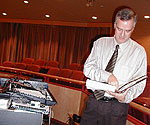By Bob Kelleher
Minnesota Public Radio
October 24, 2002
A new music performance center opens to the public this weekend on the campus of the University of Minnesota Duluth. The $9.2 million dollar Weber Music Hall opens Friday with a concert by Clarinetist Richard Stoltzman. But first, the hall had to be tuned to perfect its already near perfect acoustics.
| |
|
|
|
||
The Weber Music Hall is a stunning addition to the Duluth Campus. Its dazzling copper dome towers above the cluster of campus buildings. Architect Cesar Pelli expects the hall's tonal qualities to be as striking as it's visual impact.
For acoustician Russell Cooper, there's two ways to tune a hall: high tech and low tech. Cooper is with Jaffe Holden Acoustics, which worked alongside the architect to create near perfect sound. Cooper says Weber Hall's acoustics are a happy surprise.
According to Cooper, "I'm blown away. I really am," he says. "This is a small hall: 350 seats. And yet it has the sound of a symphonic hall. It's really quite amazing."
Cooper measures the hall with meters, sound generators, and a stack of audio speakers at center stage. He tests reverberation with an electronic blast called a shotgun.
He listens carefully as the shotgun sends a loud crash through the loudspeakers.
"It's an indication of any echoes," Cooper says, "or any anomalies, acoustic anomalies in the hall. You can hear the pulse. And then if you can hear the return of the pulse, well, that's not good."
There's another important, low tech, test. Cooper claps: first from the hall's balcony level, and then on the main floor.
"It's interesting," he says, "When I clapped from up there, you heard what's called a flutter echo, ticka, ticka, ticka, which is really no problem, because no one is really creating music up there. But down on the stage here it really doesn't occur."
The real test is high tech. It's a loud, obnoxious sound, called pink noise, that sounds like gas jets filling a hot air balloon.
"And then we're going to stop it," he says, flicking a switch. "And we're going to measure the time that it takes for the sound to go to inaudibility. That's called the reverberation time. And that's the classical kind of measurement of room acoustics for concert halls."
That's the effect that's most pronounced in the nation's greatest music halls.
"You know," Cooper continues, "Carnegie Hall is probably one of the best concert halls in the world. Well, the Grateful Dead never sounded good in Carnegie Hall, because it's too alive. But the orchestra sounded good."
The great thing about UMD's Weber Hall, is that it can be tuned for the orchestra, or the Grateful Dead. By moving baffles and curtains, the hall can be re-tuned for each performance.
Weber Hall's exterior dome provides a high capped ceiling which creates the volume of a much larger hall. The building is something of a stretched oval like a football cut in half. Or, as Jack Bowman, Dean of the School of Fine Arts says, it's shaped like a gem.
"Because of the high dome," say Bowman, "and the shape of the dome, the sound from the stage goes up. It blends in the rafter area and then comes down, so you get a wonderfully rich sound in the hall."
Over several days, the hall is checked with each of the University's performance groups. Today the 106 member concert band is warming up for a sound check. Band Director Dan Eaton is delighted with the new digs.
"I think it's very cool," he says. "It's something we've really needed for a long time. You can do whatever you want basically in here." According to Bowman, "You can make it dead. You can make it really live. It's excellent for our band."
Weber Music Hall is the latest design by world famous Architect Cesar Pelli. He's better known for Malaysia's Petronas Twin Towers and the World Financial Center in New York. He's also designing the new Minneapolis Public Library. Pelli predicts that Weber Hall will be the finest small concert hall in America.
Weber Hall opens Friday for a weekend celebration, featuring clarinetist Richard Stoltzman. There are fifty more performances scheduled through the coming year.
Every seat is perfect, although acoustician Russell Cooper admits, some are more perfect that others.
"The best seat in the house is first row balcony," says Cooper. "You will find that almost in every hall." Cooper explains: "If you want the best seat, even in poor halls, sit in first row, balcony."

